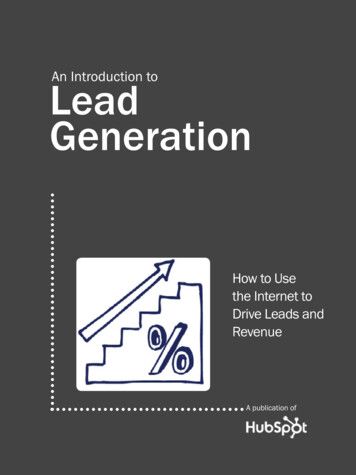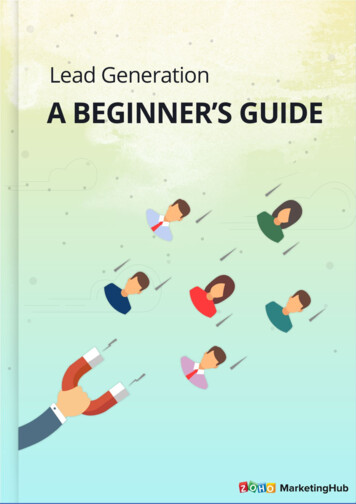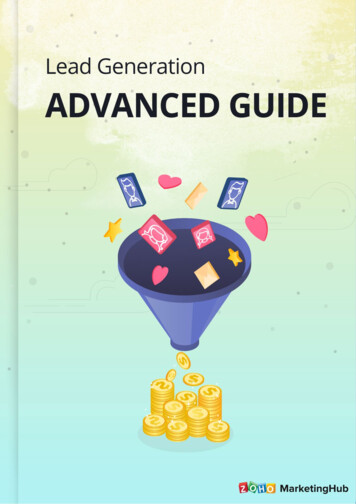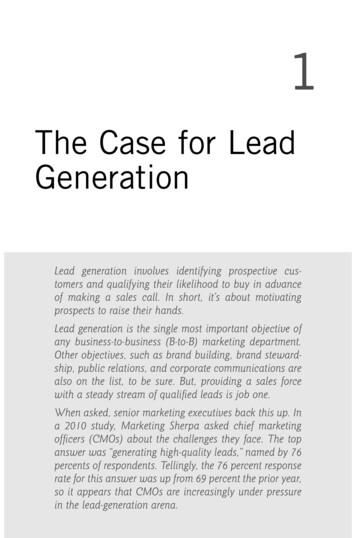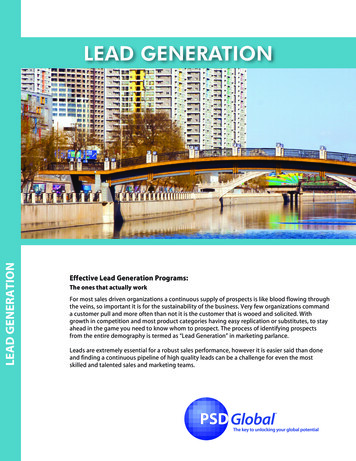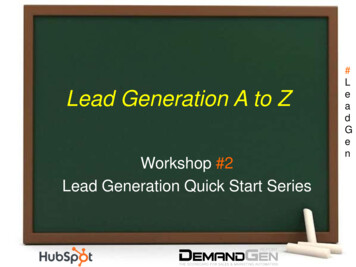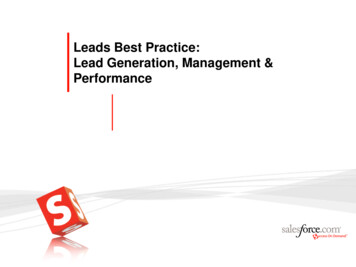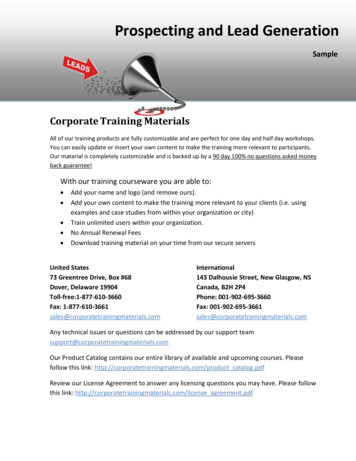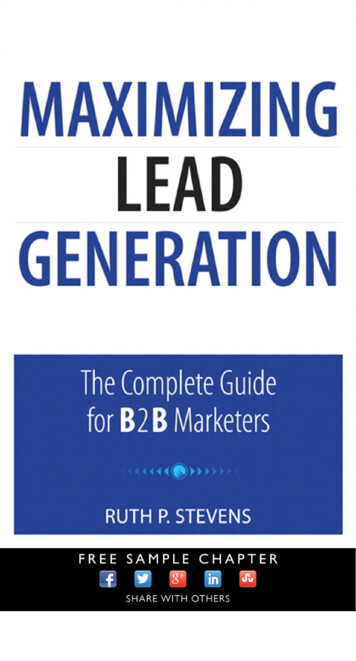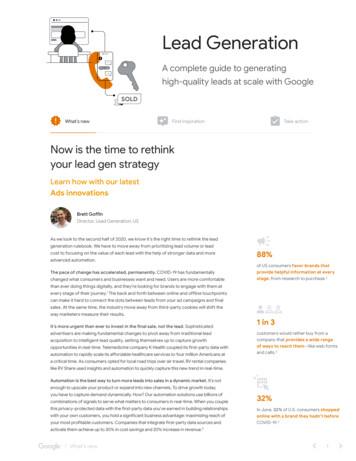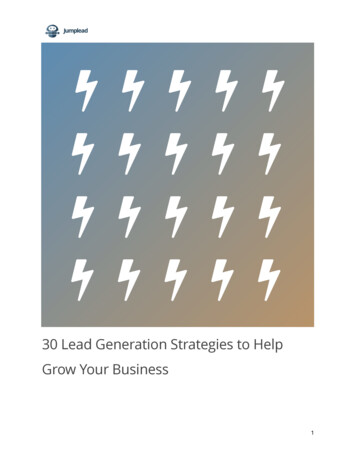
Transcription
30 Lead Generation Strategies to HelpGrow Your Business1
30 Lead Generation Strategies to HelpGrow Your BusinessCopyright 2014 Mooloop LtdAll Rights ReservedYou’re welcome to email, tweet, blog, and pass this ebook around. But please don’tchange any of the content when you do. Thanks!2
ContentsContents3Introduction: Why Generating Leadsis Critical4Webinars5Free Guides, eBooks & White Papers7Social Media9Industry Events11Blogging143
Introduction: Why Generating Leadsis CriticalA lead is the profile of informationgathered about a potential customerfrom a variety of interactions with yourcompany. Putting various processes andevents in place to capture leads isimportant to the long-term growth ofyour business, since the goal of growingyour database of leads is to eventuallyconvert them into paying customers.Lead generation is important for your business because the traditional buyingprocess has dramatically changed and therefore, requires your business tostimulate interest in your products or services across the customer pipeline.A thorough lead generation strategy is necessary to keep potential and relevantcustomers flowing into your database for ongoing nurturing by your sales andmarketing teams. The quality of the leads generated for your business is often oneof the biggest challenges, says 61% of B2B marketers surveyed. With that in mind,here are thirty suggested tactics broken up into five categories to help yourcompany generate the right leads on a consistent basis.4
Webinars1. Include a strong call-to-action at the end of a content-rich webinar your companyhosts to help drive viewers to sign up for future updates from your company on thesubjects covered during the session. The call to action should relate to the topicscovered, as well as what type of leads you’re hoping to generate.2. Co-host with relevant industry experts to help draw in their audience of relevantviewers to your webinar. Coordinate with these influencers to share content abouttheir participation in your webinar on their blog and social channels to help drivefurther visibility, traffic and potential leads.3. Mention and share links to other pieces of relevant content created by yourcompany in your webinar that live on landing pages with sign-up forms on yourwebsite. Viewers can then convert to leads if they choose to sign-up and downloadan eBook, white paper or other form of premium content your company offers.5
4. Keep the webinar registration form on your website thorough to ensure qualityleads, yet concise to make it simple for registrants to sign-up. Be sure to onlyinclude 4 to 5 fields on your sign-up form to achieve the right balance of quality andquantity when it comes to your leads. Don’t be discouraged by a low number ofattendees, since 40% to 50% of registrants on average attend a webinar they signedup for.5. Add more ways for viewers to stay in touch with your company after thecompletion of the webinar. This could include adding anything from links or linkedicons to your social media channels, a sign-up form for your email list, the RSS feedfor your blog content and more. In many cases, a past webinar viewer will becaptured as a lead from another marketing channel at another time once theybecome more familiar with your brand over time.6. Create follow-up opportunities either through continued conversations about thewebinar on Twitter, by sharing the slides from the webinar on SlideShare,6
announcing the next webinar hosted by your company and more to insightcontinued interactions with your company. This strategy will help your businessprovide as much value as possible to viewers before, during and after your webinarto foster an ongoing bond with them overtime.Free Guides, eBooks & White Papers7. Educate readers with topics relevant to their interests and your offerings in theform of eBooks, white papers, free guides and other forms of premium content.This information should help solve ongoing problems faced by your targetdemographic to eventually associate your business with the topics covered in yourcontent. Listen to feedback from existing customer to best understand the type ofcontent that will help educate them, as well as potential leads.8. Allow contributions from industry experts and influencers related to the subjectof the long-form content you’re developing. These individuals bring an originalperspective that can add needed credibility to your content, as well as a relevantaudience willing to share their content across social media. Both the originalperspective and relevant audiences of the contributors can help drive more leadsand longevity to each piece.7
9. Create an optimized landing page for each of piece of content to live on thatcontains a sign-up form, a description of the resource, benefits of the resource,trust elements like company testimonials, images related to the content and moreto help sell the value of the content. The more convincing the landing page is atselling your guides, eBooks or white papers, the more likely you’ll increase the leadsgenerated from these resources.10. Include a healthy combination of high level insights on the topic you’re coveringin your pieces of premium content, as well as actionable tips that illustrate how toexecute against the larger ideas presented.Adding both the theory as well as the application of the information shared isimportant to accommodate different ways people absorb content. The more youaccommodate to different types of learners, the more likely your content willresonate with readers and help covert more of them into leads.11. Finish the long-form premium content your business creates with a strong callto-action to help convince readers to try your services, activate a free trial, use apromo code for the discounted use of your offerings, download other relatedcontent and more to help insight them to convert to into a lead.12. Recommend more long-form content to your existing customers to help growyour database of contacts. Use your eBooks, guides and white papers to fuel theword of mouth about your business by recommending other pieces of content fromyour company that relate to the subject of the original content the existing reader8
downloaded. This recommendation could come in the form of an email triggered bydownloads a reader has chosen, a footer prompt at the bottom of your content’sdownload page, by using display advertising to target past visitors that performedan action and more.Social Media13. Share images, snippets of information and other interesting aspects of yourcontent from blog posts, eBooks, white papers, infographics and elsewhere on yoursocial media channels. This content drives traffic, engagement and visibility to theseresources, which down the pipeline can help generate more leads. Create a uniquepost for each piece of content, specific to the intricacies of each social channel yourbusiness shares its content on.14. Utilize paid social advertising on LinkedIn, Facebook or Twitter to make the mostof the reach of these social channels with updates focused around your mostvaluable content. For example, use Twitter’s promoted tweets to get your tweetsabout your eBooks more traction on the social channel, which should lead to moretraffic, engagement and visibility of your tweets.9
When spending money on promoting your content to a wider audience on socialmedia, stick to mostly sharing content that requires a sign-up form to view. Thisway you’ll be able to more effectively capture leads attributed to the money youapplied to paid advertising.15. Hold contests, giveaways and sweepstakes on social media to drive yourfollowers and non-followers to sign-up to your email list in order to enter thepromotion. This is one way of converting people interacting with you on socialmedia into long-term subscribers interested in viewing your future content, if theyopted in when they initially signed up for your contest.16. Share incentives with your social following to encourage them to sign-up to youremail list. Many businesses offer 10-20% off a shopper’s first purchase, once theysubscribe and become a lead. Provide similar one time offers to your potentialcustomers, and then share this offering on your social accounts to continue to alertyour audience of its existence and value.17. Provide world-class customer service across your social media channels to helpnurture your relationship with your social following and existing customers.Reacting to the concerns, comments and complaints of your customers across10
social media in a friendly and timely manner will go a long way towards buildingtrust with potential leads and existing customers. Moments of delightful customerservice often help fuel word of mouth marketing for your business from existingcustomers. According to Forrester Analyst, Zachary Reiss-Davis, "people you knowand respect online are the most important sources of discovery when you'relooking for new things to buy.” Use social media to help turn existing customersinto your most vocal advocates, generating more leads for your business.18. Similar to the idea of holding a webinar, host a Twitter chat, a Facebook chat ora Google Hangout on Air to create a real-time interactive experience with youraudiences online. Create an engaging session on a valuable topic for your targetcustomers; invite industry leaders and customers alike to join in on a moderateddiscussion. Showcasing a human face during these sessions can help your businessbetter foster trust amongst your audience, which will likely help you gather moreleads from your social community.Industry Events19. Encourage sign-ups to your email list as a form of entry into a contest,sweepstakes or promotion your company is hosting at an event. The sign-up can bedone through one of many apps on a tablet or by hand with pencil and paper. Makesure the prize that is being awarded to the winners is relevant to your company’sofferings to ensure the quality of your leads. For instance, many companies giveaway iPads as prizes for contests, which is quite often completely unrelated to theirbusiness and draws the attention of anyone looking for free swag.20. Set customer targets based off of the event’s attendees and encourage them tovisit your company’s table, booth or area. If need be, incentivize them with free11
swag, food or alcohol to get the opportunity to be in front of them and share thevalue of your products or services through a conversation to see if they are facingissues your company helps solve. If they do encounter issues that are relevant toyour company’s offerings, then demo your product or service for these attendees ifthey are interested. Don’t ever be pushy, but offer your contact info to theattendees at your booth and be sure to gather their contact info as well to ensurethere is opportunity to follow up after the event.21. Whether you’re giving a demo, hosting a contest or any other kind ofengagement with attendees at an event, be sure to deliver value no matter what tocreate warm leads. The more value you’re adding to a person’s day, the more likelythey will listen to information about your product and service offerings. Whenyou’ve presented attendees with more value through free content, relevant swag orinsights on industry trends, the better your engagement will be with them at theevent and for the future.12
22. Communicate with event attendees before, during and after the event to get themost of your time in front of them with a variety of communication tactics. Sendregistration emails before the event as well as reminders about the date, time andlocation to keep potential attendees engaged. Use social media to alert attendeesof your presence at a large-scale industry event to make sure you aren’t lost in thecrowd of other companies and competitors.23. Create an event within an event to overpower other companies’ presence at alarge conference. Take a product demo to the next level by offering a one of a kindexperience to attendees like the free Callaway sponsored Uber rides at the U.S.Open in 2013 or the truth-or-dare themed campaign Ray Ban recently launched atSundance Festival to capture the attention of potential customers.13
24. Follow up with attendees with relevant messaging via email from gatheredinformation acquired at the event. The follow up should contain contextuallyrelevant information gathered by the members of your staff to help personalize themessage and make it more effective at engaging the potential prospect. Sendoriginal content to prospects to help match any needs or problems they are facing,based off of conversations had at the event.Offer to move the conversation from an email to a phone call at the convenience ofthe prospect, since a phone call is more likely to convert customers then emailalone.Blogging25. Guest blog on other relevant websites to draw traffic, links and greater visibilityto your company’s blog efforts. Overtime, a consistent guest blogging strategy canwork to help drive thought leadership in your industry in relation to the topics yourcompany wants to be associated with.Start by identifying websites that have similar audiences to your customer base andreach out to the other website’s blog editors to see if they accept guest contributorsfor their blogs.26. Add a call-to-action at the end of your blog posts for readers to sign-up for youremail list, try a free trial of your products, download a long-form piece of contentlike an eBook and more.The addition of this call-to-action at the end of your blog posts helps bring moreengagement with your company and its ecosystem of content from readers.14
Spelling out next steps for readers online is often what it takes to get them toengage with your company further.27. Focus on naturally including the keywords that your business should rank highlyfor in the search engines by adding them to the headline and the body of your blogposts frequently.Linking some of these relevant keywords within yo
Lead generation is important for your business because the traditional buying process has dramatically changed and therefore, requires your business to stimulate interest in your products or services across the customer pipeline. A thorough lead generation strategy is necessary to keep potential and relevant customers flowing into your database for ongoing nurturing by your sales and .
